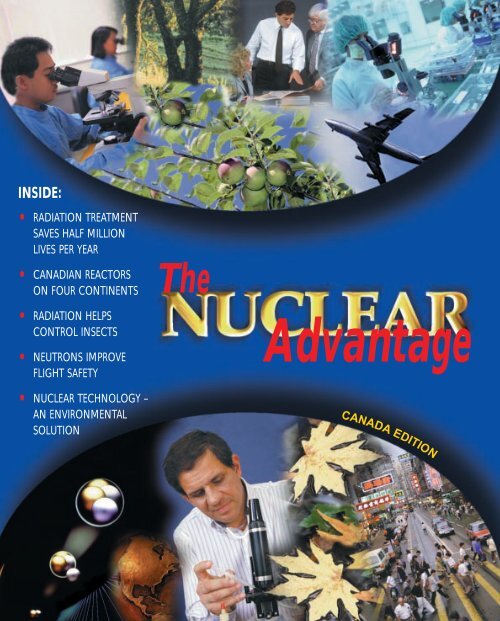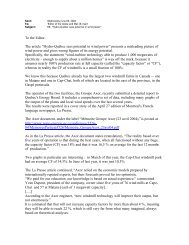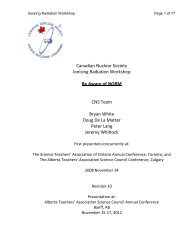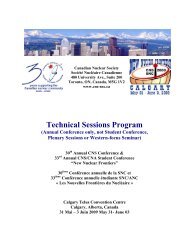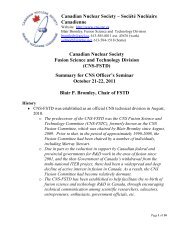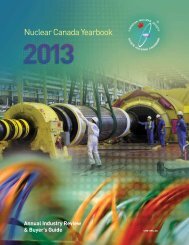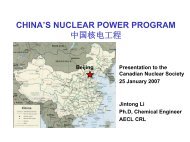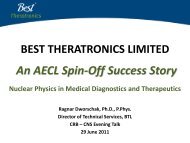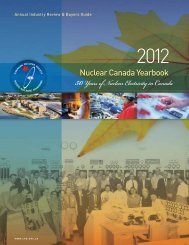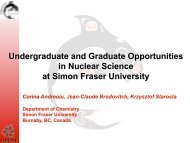Nuclear Advantage - Canada Edition - media.cns-snc.ca
Nuclear Advantage - Canada Edition - media.cns-snc.ca
Nuclear Advantage - Canada Edition - media.cns-snc.ca
Create successful ePaper yourself
Turn your PDF publications into a flip-book with our unique Google optimized e-Paper software.
INSIDE:<br />
• RADIATION TREATMENT<br />
SAVES HALF MILLION<br />
LIVES PER YEAR<br />
• CANADIAN REACTORS<br />
ON FOUR CONTINENTS<br />
• RADIATION HELPS<br />
CONTROL INSECTS<br />
• NEUTRONS IMPROVE<br />
FLIGHT SAFETY<br />
• NUCLEAR TECHNOLOGY –<br />
AN ENVIRONMENTAL<br />
SOLUTION<br />
The<br />
<strong>Advantage</strong><br />
CANADA EDITION
RADIOACTIVE COBALT<br />
TREATMENT SAVES HALF A<br />
MILLION LIVES PER YEAR<br />
Almost fifty years ago Canadian <strong>ca</strong>ncer<br />
researcher, Dr. Harold Johns, developed<br />
a machine for treating <strong>ca</strong>ncer. It used<br />
radiation from a radioactive cobalt isotope<br />
produced at the Chalk River Laboratories in<br />
Ontario, <strong>Canada</strong>. This treatment proved so<br />
effective that it has been adopted throughout<br />
the world and today is credited by health<br />
authorities with saving an estimated 500,000<br />
lives per year.<br />
The treatment is based on the fact that <strong>ca</strong>ncer<br />
cells are more active than adjoining normal<br />
cells. By exposing the <strong>ca</strong>ncer cells to controlled<br />
doses of radiation from the cobalt isotope,<br />
these more active cells are killed while normal<br />
cells are less affected and able to survive the<br />
treatment.<br />
Serving in so many ways…<br />
To many people, the word “nuclear” is often related to the nuclear power industry which, in a few<br />
de<strong>ca</strong>des, has grown to produce 17% of the world’s electri<strong>ca</strong>l energy and continues to offer signifi<strong>ca</strong>nt<br />
benefits to our global environment.<br />
<strong>Nuclear</strong> science and technology extends to many<br />
fields. <strong>Nuclear</strong> appli<strong>ca</strong>tions in the medi<strong>ca</strong>l, pharmaceuti<strong>ca</strong>l<br />
and health fields benefi<strong>ca</strong>lly affect millions<br />
of people every year. In other ways, nuclear<br />
technologies help to produce better-quality goods<br />
and services that improve our day-to-day living.<br />
This pamphlet is intended to provide the reader<br />
with a better understanding of the uses and benefits<br />
of nuclear technology.<br />
RADIOACTIVE IODINE<br />
ISOTOPES DIAGNOSE CANCER<br />
McMaster University, one of <strong>Canada</strong>’s top<br />
science universities, recently developed a<br />
process to conveniently and safely produce<br />
very high quality radioactive iodine isotopes at its<br />
nuclear research reactor. Radioactive iodine isotopes<br />
are used to diagnose and treat thyroid and prostate<br />
<strong>ca</strong>ncers. Today, McMaster University produces a substantial<br />
quantity of all the radioactive iodine isotopes<br />
used in the world.<br />
F ACT:<br />
Medi<strong>ca</strong>l appli<strong>ca</strong>tions<br />
– Over 40,000 medi<strong>ca</strong>l<br />
procedures using radioactive isotopes<br />
are performed each day in North<br />
Ameri<strong>ca</strong>n hospitals and clinics to diagnose<br />
and treat various diseases. One Canadian company,<br />
MDS Nordion Inc., supplies most of the major diagnostic<br />
isotopes used in the world. These isotopes are produced at<br />
<strong>Canada</strong>’s Chalk River Laboratories in Ontario.<br />
100 YEARS OF X-RAYS<br />
Few scientific discoveries have had as great an impact on medicine as the<br />
appli<strong>ca</strong>tion of x-ray techniques. During the twentieth century, the X-ray<br />
has become the primary diagnostic tool in modern medi<strong>ca</strong>l practice,<br />
allowing physicians to improve their understanding of a patient’s condition<br />
and avoid invasive surgery.<br />
World Health Organization statistics show that millions of lives each year have<br />
been positively affected by this technology. X-rays are a nuclear technology.
Safety & environmental benefits of nuclear technology<br />
NEUTRONS IMPROVE<br />
FLIGHT SAFETY<br />
All high-temperature jet engine<br />
turbine blades manufactured<br />
in <strong>Canada</strong> are inspected for<br />
manufacturing flaws through a<br />
process <strong>ca</strong>lled, “neutron radiography”.<br />
It uses neutrons produced in a<br />
nuclear reactor to produce images of<br />
the internal structure of the turbine<br />
fan blades. This process ensures that<br />
there are no hidden flaws in the<br />
blades and reduces the potential for<br />
these blades to break in flight and<br />
damage the engine, the wing or even<br />
the aircraft fuselage.<br />
FACT: <strong>Nuclear</strong> Technology<br />
helps find Land Mines<br />
– One approach to land mine<br />
detection involves the appli<strong>ca</strong>tion<br />
of nuclear technologies.<br />
Both X-rays and gamma rays have<br />
been used successfully in detecting<br />
land mines that kill or injure<br />
an estimated<br />
23,000<br />
people<br />
annually.<br />
RADIATION USED TO<br />
STERILIZE INSECTS<br />
When traditional chemi<strong>ca</strong>l treatments failed to control<br />
insect infestation, <strong>Canada</strong>’s Okanagan Valley<br />
fruit growers looked to the nuclear industry for<br />
assistance. The<br />
concept is simple:<br />
By exposing adult<br />
insects to a dose of<br />
radiation, they<br />
become sterile.<br />
When released in<br />
nature, they mate<br />
with fertile females<br />
but the sterile eggs<br />
never hatch and<br />
insect populations<br />
diminish.<br />
The project employs about 100 people and sterilizes<br />
two million insects a day.<br />
F ACT:<br />
Helping the Environment<br />
– Over the last 30 years, use of the 22<br />
CANDU nuclear power reactors in <strong>Canada</strong><br />
has avoided putting a billion tonnes of <strong>ca</strong>rbon<br />
dioxide into the atmosphere.<br />
CANADIAN ENVIRONMENTALISTS<br />
SUPPORT NUCLEAR RESEARCH<br />
Canadian environmentalists<br />
are seeing the<br />
advantage of applying<br />
nuclear technologies to<br />
environmental problems.<br />
For example, waste discharges<br />
from industrial and<br />
domestic sources are often<br />
laden with chemi<strong>ca</strong>ls and<br />
organisms which are harmful<br />
to the natural environment.<br />
<strong>Nuclear</strong> research<br />
techniques have helped<br />
develop improved strains of<br />
enzymes that <strong>ca</strong>n signifi<strong>ca</strong>ntly<br />
reduce or even eliminate some forms of these pollutants.<br />
“<strong>Nuclear</strong>, naturally!” may yet become a slogan for environmentalists!
CANADA CELEBRATES<br />
53 YEARS OF<br />
NUCLEAR FISSION<br />
<strong>Canada</strong> was the second nation in<br />
the world to achieve sustained<br />
nuclear fission. It took place at<br />
Chalk River Laboratories in 1945. By<br />
1962, <strong>Canada</strong>’s first nuclear reactor to<br />
generate electricity went into service<br />
for Ontario Hydro, <strong>Canada</strong>’s largest<br />
electric utility company. The<br />
Canadian-designed CANDU ® power<br />
reactor has proven to be a reliable<br />
design and today contributes<br />
signifi<strong>ca</strong>ntly to the electricity<br />
produced in Ontario, <strong>Canada</strong>’s most<br />
industrialized province, as well as in<br />
Québec and New Brunswick. In<br />
addition to the CANDU power<br />
reactor, the SLOWPOKE and MAPLE<br />
research reactors are unique Canadian<br />
developments.<br />
CANDU REACTORS ON FOUR CONTINENTS<br />
<strong>Canada</strong> has a relatively small population of 30 million people. However, due to its high level of industrialization<br />
and high standard of living, it is the fifth largest electricity-producing nation in the world. Canadian energy<br />
production expertise is well represented in the nuclear power field, with the Canadian-designed CANDU<br />
nuclear power reactor operating or under construction on four continents. CANDUs are producing power in<br />
<strong>Canada</strong>, Korea, Argentina, Romania, Pakistan and India. Two more are presently under construction in China.<br />
CANDUs are contenders for future nuclear power requirements in Turkey<br />
and Hungary, as well as in many Asian nations considering the clean and<br />
efficient nuclear power option.<br />
ACT: <strong>Canada</strong>’s long experience in international<br />
peacekeeping operations was recognized when a<br />
former Canadian Prime Minister, Lester Pearson, was<br />
awarded a Nobel Prize for Peace. <strong>Canada</strong> has a reputation as<br />
a major trading nation, a trusted member of the international<br />
community and a strong supporter of nuclear non-proliferation<br />
and sustainable development.<br />
F<br />
<strong>Nuclear</strong> electricity production<br />
F<br />
CHINA AND KOREA CHOOSE<br />
CANADIAN REACTORS<br />
The first Canadian nuclear reactor in Korea began<br />
producing electricity in 1983. Since that time, Korea<br />
has ordered another three Canadian power<br />
reactors. Korea has also chosen<br />
the Canadian MAPLE research<br />
reactor design as the basis for its<br />
new HANARO research reactor.<br />
China has also decided to<br />
purchase two Canadian CANDU<br />
power reactors which are now<br />
under construction. China<br />
anticipates high rates of<br />
electric-energy growth and plans<br />
to develop up to 50 new nuclear<br />
power stations during the next<br />
several de<strong>ca</strong>des. China and<br />
Korea’s choice of Canadian<br />
reactors is a vote of confidence<br />
for Canadian nuclear technology.<br />
ACT: The CANDU nuclear<br />
power reactor was chosen<br />
by the Engineering Institute of <strong>Canada</strong> as<br />
one of the ten most signifi<strong>ca</strong>nt Canadian<br />
engineering achievements of the twentieth century.
FACT: Canadian <strong>Nuclear</strong><br />
Technology Assists<br />
US Space Program<br />
– The <strong>ca</strong>use of the<br />
explosion of the US<br />
Challenger Space<br />
Shuttle was<br />
determined to be<br />
faulty seals. The engine<br />
manufacturer, Morton Thiokol,<br />
turned to scientists at the Chalk River<br />
Laboratories to assist in the engineering and<br />
design of new seals that are now used.<br />
<strong>Nuclear</strong> research and regulation<br />
TAKING RESPONSIBILITY<br />
ACanadian solution to the safe and permanent storage of used nuclear<br />
fuel has been researched and engineered for almost two de<strong>ca</strong>des. It<br />
involves burying this material deep underground in undisturbed<br />
granite formations. Geologic research has shown that these formations have<br />
remained undisturbed for 1.5 billion years or more. A seven-year scientific and<br />
public review of this approach has just been completed – an independent panel<br />
found the concept techni<strong>ca</strong>lly acceptable. The priority now is to ensure public<br />
understanding and acceptance of this approach.<br />
ASSURING<br />
PERFORMANCE<br />
The development of nuclear<br />
technologies <strong>ca</strong>rries risks that require<br />
good techni<strong>ca</strong>l judgement and <strong>ca</strong>reful<br />
monitoring. Canadian nuclear licensing<br />
standards are set by an independent<br />
agency of the Government of <strong>Canada</strong>.<br />
<strong>Canada</strong>’s approach to nuclear regulation is<br />
similar to its aircraft and flight safety regulation,<br />
with high standards of industry selfregulation.<br />
Such measures, when combined<br />
with the regulator’s own inspections and<br />
reviews, ensure high levels of public<br />
confidence in the handling of nuclear technologies.<br />
RECOMBINANT<br />
DNA – ARE THE<br />
ANSWERS IN<br />
OUR GENES?<br />
Although Recombinant<br />
DNA sounds esoteric,<br />
research into human cell<br />
genetics at the Chalk River<br />
Laboratories in the 1970’s<br />
signifi<strong>ca</strong>ntly advanced genetic<br />
research and laid the<br />
foundation for medi<strong>ca</strong>l research<br />
programs now pursued by scientists all over the world. Chalk River<br />
research findings, first reported in 1979 by Dr. H. C. Birnboim, now at<br />
the Ottawa Regional Cancer Clinic, have been cited nearly 10,000<br />
times in work done by other <strong>ca</strong>ncer researchers.<br />
FACT: Canadian Awarded Nobel<br />
Prize in <strong>Nuclear</strong> Physics<br />
Dr. Bertram Brockhouse was awarded<br />
the 1994 Nobel Prize in Physics.<br />
Dr. Brockhouse received his Nobel award<br />
for work undertaken at the Chalk River<br />
Laboratories of Atomic Energy of <strong>Canada</strong><br />
Limited (AECL).
PICKERING NUCLEAR POWER STATION<br />
In <strong>Canada</strong>, nuclear power plants are often lo<strong>ca</strong>ted in close<br />
proximity to large population centers. The Pickering <strong>Nuclear</strong><br />
Generating Station is lo<strong>ca</strong>ted right in the city of Pickering<br />
(population: 75,000) and is 40 kilometers from the city of<br />
Toronto (population 3.5 million).<br />
CANADA’S NUCLEAR LEADERSHIP –<br />
A DISTINGUISHED HISTORY<br />
For almost half a century, the Canadian Government has stood<br />
behind the Canadian nuclear industry. That commitment goes<br />
right to the top. “It is no secret that I am personally a strong supporter<br />
of the CANDU nuclear power system,” notes <strong>Canada</strong>’s Prime<br />
Minister Jean Chretien. “I believe that the technology is safe and<br />
unmatched for performance, and that CANDU is a product in which<br />
<strong>Canada</strong> <strong>ca</strong>n take immense pride.”<br />
FEEDBACK<br />
THE CANADIAN<br />
NUCLEAR WORKERS<br />
COUNCIL<br />
Concerned that the public was not<br />
getting the most accurate information<br />
about the signifi<strong>ca</strong>nt medi<strong>ca</strong>l,<br />
environmental and economic benefits of<br />
their industry, several Canadian labor<br />
unions with members in the nuclear<br />
industry agreed a few years ago to<br />
support the creation of a <strong>Nuclear</strong><br />
Workers Council. The Council's<br />
mandate is to promote factual<br />
information on the benefits of nuclear<br />
energy to Canadian workers and the<br />
Canadian people.<br />
Although the main membership in the<br />
Council is unionized workers at<br />
Ontario Hydro's nuclear power<br />
stations, some Council members are<br />
involved with uranium mining as well<br />
as other aspects of the nuclear industry,<br />
including research.<br />
FOR MORE INFORMATION<br />
ON NUCLEAR ISSUES CONTACT<br />
Frequently Asked Questions..........http://www.ncf.<strong>ca</strong>rleton.<strong>ca</strong>/~cz7251/<br />
IAEA - United Nations Agency .....http://www.iaea.or.at<br />
<strong>Nuclear</strong> Energy Institute.................http://www.nei.org/<br />
Greenpeace........................................http://www.greenpeace.org/index.shtml<br />
Medi<strong>ca</strong>l ..............................................http://nuc-med-read.uthscsa.edu/williams/wmstoc.htm<br />
CANDU <strong>Nuclear</strong> Reactors .............http://www.aecl.<strong>ca</strong><br />
Isotopes – MDS Nordion ................http://www.mds.nordion.com/home.html<br />
Canadian <strong>Nuclear</strong> Assoc.................http://www.cna.<strong>ca</strong><br />
This information supplement was prepared by Keewatin Publi<strong>ca</strong>tions for public distribution.<br />
All views and opinions are the responsibility of Keewatin Publi<strong>ca</strong>tions. Keewatin Publi<strong>ca</strong>tions<br />
<strong>ca</strong>n be reached by email at: Keewatin@sk.sympatico.<strong>ca</strong><br />
119804


